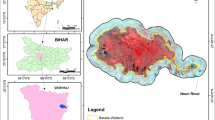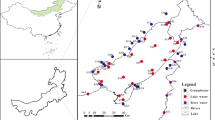Abstract
The study investigates the hydrochemical type and characteristics of river water in permafrost regions in the Tibetan Plateau by analyzing 532 samples collected from the source region of the Yangtze River. The hydrochemical type of the river water was Cl−-Na+-SO42−, and its hydrochemical characteristics were primarily influenced by the soil sources, though the influence of the sea sources and anthropogenic factors could not be ignored. Significant negative correlations were found between temperature and NO3−, SO42−, Mg2+, Ca2+, and between precipitation, relative humidity, and SO42− and Mg2+ in the river water. River water in the higher altitudes of over 5000 m above sea level was mainly recharged from glacier snowmelt water and by the supra-permafrost water and precipitation at the altitudes between 3500 and 5000 m above sea level. The controlled sources of hydrochemical characteristics of glacier snowmelt water were different for different ablation rates in the area with elevations of over 5000 m above sea level. Different hydrochemical types in different ablation rates implied the hydrochemical type was extremely sensitive to ablation periods in areas with elevation of over 5000 m above sea level. However, hydrochemical type was not sensitive to ablation periods from 3500 to 5000 m above sea level. The ionic concentration of glacier snowmelt water was mainly controlled by pollutants in glaciers and snow. Melting rates of glacier snowmelt water also had a certain effect on ionic concentration. Meanwhile, the stability of the hydrochemical type implied river water mainly controlled the hydrochemical type from 3500 to 5000 m above sea level. Hydrochemical type had no effect on elevation in end ablation.






Similar content being viewed by others
References
Balagizi CM, Darchambeau F, Bouillon S, Yalire MM, Lambert T, Borges AV (2015) River geochemistry, chemical weathering, and atmospheric CO2, consumption rates in the Virunga Volcanic Province (East Africa). Geochem Geophys Geosyst 16(8):2637–2660
Bo Y, Liu C, Jiao P, Chen Y, Cao Y (2013) Hydrochemical characteristics and controlling factors for waters’ chemical composition in the Tarim Basin, Western China. Chem Erde - Geochem 73(3):343–356
Cao WG, Yang HF, Liu CL, Li YJ, Bai H (2018) Hydrogeochemical characteristics and evolution of the aquifer systems of Gonghe Basin, Northern China. Geosci Front 9(3):907–916
Cortes JE, Muñoz LF, Gonzalez CA, Niño JE, Polo A, Suspes A, Siachoque SC, Hernández A, Trujillo H (2016) Hydrogeochemistry of the formation waters in the San Francisco field, UMV basin, Colombia—a multivariate statistical approach. J Hydrol 539:113–124
Diamantini E, Lutz SR, Mallucci S, Majone B, Merz R, Bellin A (2018) Driver detection of water quality trends in three large European river basins. Sci Total Environ 612:49–62
Fang F, Li Z, Shuang J, Dong Z, Wang F (2012) Hydrochemical characteristics and solute dynamics of meltwater runoff of Urumqi Glacier no.1, eastern Tianshan, Northwest China. J Mount Sci 9(4):472–482
Gaillardet J, Dupré B, Louvat P, Allègre CJ (1999) Global silicate weathering and CO2, consumption rates deduced from the chemistry of large rivers. Chem Geol 159(1–4):3–30
Gibbs RJ (1970) Mechanisms controlling world water chemistry. Science 170(3962):1088–1090
Hayashi S, Murakami S, Xu KQ, Watanabe M (2015) Simulation of the reduction of runoff and sediment load resulting from the gain for green program in the Jialingjiang catchment, upper region of the Yangtze River, China. J Environ Manag 149:126–137
Iqbal J, Nazzal Y, Howari F, Xavier C (2018) Hydrochemical processes determining the groundwater quality for irrigation use in an arid environment: the case of Liwa aquifer, Abu Dhabi, United Arab Emirates. Groundw Sustain Dev 7:212–219
Jeelani G, Shah RA, Deshpande RD, Fryar AE, Perrin J, Mukherjee A (2017) Distinguishing and estimating recharge to karst springs in snow and glacier dominated mountainous basins of the western Himalaya, India. J Hydrol 550:239–252
Karim A, Veizer J (2000) Weathering processes in the Indus River basin: implications from riverine carbon, sulfur, oxygen, and strontium isotopes. Chem Geol 170(1):153–177
Li Z, Feng Q, Liu W, Wang T, Cheng A, & Gao Y, et al. (2014) Study on the contribution of cryosphere to runoff in the cold alpine basin: a case study of hulugou river basin in the qilian mountains. Global & Planetary Change, 122:345–361
Li J, Yao Z, Liu Z, Wang R, Wu S (2015) Hydrochemistry and its controlling factors of rivers in the source region of the Yangtze River on the Tibetan Plateau. J Geochem Explor 155:76–83
Li Z, Feng Q, Wang QJ, Yong S, Li J, Li Y (2016) The influence from the shrinking cryosphere and strengthening evapotranspiration on hydrologic process in a cold basin, Qilian Mountains. Glob Planet Chang 144:119–128
Li ZJ, Song LL, Ma JZ, Li YG (2017) The characteristics changes of pH and EC of atmospheric precipitation and analysis on the source of acid rain in the source area of the Yangtze River from 2010 to 2015. Atmos Environ 156:61–69
Li Z, Feng Q, Zongjie L, Ruifeng Y, Juan G, Yuemin L (2018a) Climate background, fact and hydrological effect of multiphase water transformation in cold regions of the Western China: a review. Earth-Sci Rev 190:33–57
Li ZJ, Li ZX, Song LL, Ma JZ, Song Y (2018b) Environment significance and hydrochemical characteristics of supra-permafrost water in the source region of the Yangtze River. Sci Total Environ 644:1141–1151
Mapoma HWT, Xie X, Zhang L, Nyirenda MT, Maliro A, Chimutu D (2016) Hydrochemical characteristics of rural community groundwater supply in Blantyre, Southern Malawi. J Afr Earth Sci 114:192–202
Meybeck M (2003) Global occurrence of major elements in rivers. Treatise Geochem 5(1):207–223
Niu H, Kang S, Shi X, He Y, Lu X, Shi X, Paudyal R, du J, Wang S, du J, Chen J (2017) Water-soluble elements in snow and ice on Mt. Yulong. Sci Total Environ 574:889–900
Sarin MM, Krishnaswami S (1984) Major ion chemistry of the Ganga–Brahmaputra River systems, India. Nature 312(5994):538–541
Wanda EMM, Mamba BB, Msagati TAM (2016) Hydrochemical modelling of water quality in terms of emerging micropollutants in Mpumalanga, Gauteng and north west provinces. Physics Chem Earth A B C 100
Wang G, Li Y, Wang Y, Shen Y (2007) Impacts of alpine ecosystem and climate changes on surface runoff in the headwaters of the Yangtze River. J Glaciol Geocryol 29(2):159–168 (In Chinese)
Wang J, Jin M, Jia B, Kang F (2015) Hydrochemical characteristics and geothermometry applications of thermal groundwater in northern Jinan, Shandong, China. Geothermics 57:185–195
Yu GA, Brierley G, He QH, Wang Z, Blue B, Ma Y (2014) An environmental gradient of vegetative controls upon channel planform in the source region of the Yangtze and Yellow rivers. Catena 119(119):143–153
Zhang B, Song X, Zhang Y, Han D, Tang C, Yu Y, Ma Y (2012) Hydrochemical characteristics and water quality assessment of surface water and groundwater in Songnen Plain, Northeast China. Water Res 46(8):2737–2748
Zhu YL, Chen J, Chen GC (2011) Runoff variation and its impacting factors in the headwaters of the Yangtze River in recent 32 years. J Yangtze River Sci Res Inst 28(6):1–4
Funding
This study was supported by the National “Plan of Ten Thousand People” Youth Top Talent Project; the Second Tibetan Plateau Scientific Expedition and Research Program (STEP; Grant No. 2019QZKK0405); the Youth Innovation Promotion Association, CAS (2013274); the open funding from the Key Laboratory of Mountain Hazards and Earth Surface Process; the open funding from the State Key Laboratory of Loess and Quaternary Geology (SKLLQG1814); the Open Foundation of MOE Key Laboratory of Western China’s Environmental System, Lanzhou University; the Fundamental Research Funds for the Central Universities (lzujbky-2018-kb01); and the National Nature Science Foundation of China (91547102).
Author information
Authors and Affiliations
Corresponding authors
Additional information
Responsible editor: Philippe Garrigues
Publisher’s note
Springer Nature remains neutral with regard to jurisdictional claims in published maps and institutional affiliations.
Rights and permissions
About this article
Cite this article
Li, ZJ., Li, ZX., Song, LL. et al. Response mode of hydrochemical types of river water to altitude gradient in alpine regions. Environ Sci Pollut Res 26, 35767–35778 (2019). https://doi.org/10.1007/s11356-019-06476-1
Received:
Accepted:
Published:
Issue Date:
DOI: https://doi.org/10.1007/s11356-019-06476-1




